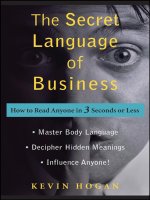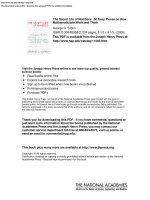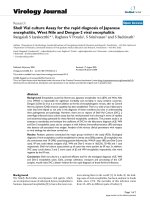The secret code of japanese candlesticks
Bạn đang xem bản rút gọn của tài liệu. Xem và tải ngay bản đầy đủ của tài liệu tại đây (2.79 MB, 213 trang )
The Secret Code of Japanese Candlesticks
THE SECRET CODE OF JAPANESE
CANDLESTICKS
Felipe Tudela
Copyright © 2008
Felipe Tudela
Email (for orders and customer service enquiries):
Visit our Home Page on www.wiley.com
All Rights Reserved. No part of this publication may be reproduced, stored in a retrieval system or
transmitted in any form or by any means, electronic, mechanical, photocopying, recording, scanning or
otherwise, except under the terms of the Copyright, Designs and Patents Act 1988 or under the terms of
a licence issued by the Copyright Licensing Agency Ltd, 90 Tottenham Court Road, London W1T 4LP,
UK, without the permission in writing of the Publisher. Requests to the Publisher should be addressed
to the Permissions Department, John Wiley & Sons Ltd, The Atrium, Southern Gate, Chichester, West
Sussex PO19 8SQ, England, or emailed to , or faxed to (+44) 1243 770620.
Designations used by companies to distinguish their products are often claimed as trademarks. All
brand names and product names used in this book are trade names, service marks, trademarks or
registered trademarks of their respective owners. The Publisher is not associated with any product or
vendor mentioned in this book.
This publication is designed to provide accurate and authoritative information in regard to the subject
matter covered. It is sold on the understanding that the Publisher is not engaged in rendering
professional services. If professional advice or other expert assistance is required, the services of a
competent professional should be sought.
Other Wiley Editorial Offices
John Wiley & Sons Inc., 111 River Street, Hoboken, NJ 07030, USA
Jossey-Bass, 989 Market Street, San Francisco, CA 94103-1741, USA
Wiley-VCH Verlag GmbH, Boschstr. 12, D-69469 Weinheim, Germany
John Wiley & Sons Australia Ltd, 42 McDougall Street, Milton, Queensland 4064, Australia
John Wiley & Sons (Asia) Pte Ltd, 2 Clementi Loop #02-01, Jin Xing Distripark, Singapore 129809
John Wiley & Sons Canada Ltd, 6045 Freemont Blvd, Mississauga, Ontario, L5R 4J3, Canada
Wiley also publishes its books in a variety of electronic formats. Some content that appears in print
may not be available in electronic books.
Library of Congress Cataloging in Publication Data
Tudela, Felipe.
The secret code of Japanese candlesticks / Felipe Tudela.
p. cm.
Includes bibliographical references and index.
ISBN 978-0-470-99610-2 (cloth : alk. paper)
1. Investment analysis. 2. Stocks—Charts, diagrams, etc. I. Title.
HG4529.T83 2008
332.63 2042—dc22
2007050378
British Library Cataloguing in Publication Data
A catalogue record for this book is available from the British Library
ISBN 978-0-470-99610-2
Typeset in 10/12pt Times by Integra Software Services Pvt. Ltd, Pondicherry, India
Printed and bound in Great Britain by TJ International Ltd., Padstow, Cornwall, UK
Contents
Acknowledgments
vii
Introduction
ix
1
The Truth about Japanese Candlesticks
1
2
The Spirit of Sokyu Honma’s Method: The Master and the Disciple
3
3
The Samni No Den of the Market: The Subjective Part of the Method
5
4
The Five Sakata Methods: The Objective Part of the Method
9
5
Trading with Sokyu Honma’s Method
15
6
Japanese Candlesticks: A Precision Tool within the Market’s Great
Cycle
27
Algorithm in Tabular Format for the Five Sakata Methods within
Sokyu Honma’s ‘Great Cycle’
37
8
Thirty-seven Applications Involving Indexes, Stocks, and Futures
51
9
Back to the Samni No Den
99
10
Learning to Analyze the Markets from a Trader’s Viewpoint
105
11
Your Magic Talisman
117
7
vi
Contents
12
Before Taking a Position
Think!
13
How to Exit a Trade
137
14
How to Manage Your Risk
141
15
All You Will Ever Need to Know about Stops
153
16
Putting It All Together in a Simple but Winning Approach
159
17
Trade Now!
163
18
Some Thoughts about Trading Philosophy
167
Conclusion
Appendix
125
175
What Is a Candlestick?
177
Notes
179
Bibliography
185
Index
187
Acknowledgments
I want to thank, first of all, Thomas DeMark without whom this book would not
exist. He immediately recognized the value of my work, encouraged me in my
research, and made it possible for this book to be published by John Wiley &
Sons, Ltd. I have always admired Tom’s work and his encouragement gave me the
confidence and resolve that I needed to complete this book.
I must also thank Patrick Sauty, Vice President of AFATE (French Association of
Technical Analysis), who was the first to organize a seminar in Paris in which I was
able to explain this new perspective of Japanese Candlesticks. Thanks also go to
Thiérry Béchu, former president of AFATE, teacher at Dauphine and fund manager
for SGAM (Société Générale Asset Management); Etienne Laisney, who teaches
Technical Analysis at l’ISEP and l’ESG; Julien Nebenzahl, CEO of Day by Day and
President of AFATE; and Joël Villecroze, CEO of Trium, Equity & Derivatives.
In addition, I would like to thank my friends, Don Mack, former editor of
the Traders Masterclass series at Pitman Publishing Financial Times, and Albert
Labos, teacher, trader and magician, for having shared their insightful knowledge
of markets with me.
I extend a very special and unique thank you to my wife, Annie, whose love,
company, and support helped me to create the space and time in which to do this
book.
Finally, a word of thanks to those who helped me along the way to make this
book a reality. Here I especially want to mention Cherline Daniel of Integra, Pamela
van Giessen of John Wiley & Sons, Inc., and Caitlin Cornish, Aimée Dibbens,
Karen Weller and Louise Holden of John Wiley & Sons, Ltd, whose help was
indispensable. I would also like to thank Shawn Fawcett, who provided me with
the best possible blueprint to create a book, George Robinson, who gave attentive
and focused care to the edit, and Jose Antonio Pancorvo, who also took the time to
read the book and make useful suggestions to improve it.
Lastly, a thank you is due to all of my friends and students who helped me along
the way.
Introduction
Would you like to acquire a powerful trading tool that is efficient and precise? Such
a tool exists. It is the foundation to ‘Japanese candlesticks.’ This book is about
them. You are about to discover the truth about Japanese candlesticks. It is a truth
that no one has ever explained before!
Japanese candlesticks are fashionable. Their exotic nature attracts the public to
them and they are surrounded by an aura of arcane science and seem inaccessible
to the uninitiated. They have a magic of their own – the magic of an ancient
civilization – and also have strange-sounding names – Dojo, Marubozu, etc.
However, they do not work efficiently, except for a very small number of traders.
The reason for this is that few people today are willing to study a trading method
until they master it. Candlesticks are also difficult to handle, given the diversity of
their patterns. Most important is the fact that Japanese candlesticks have a unique
master key that must be understood in order to make them work.
We are going to explain this key and illustrate it with practical examples. It will
change your way of looking at candlesticks and at markets.
1
The Truth about Japanese
Candlesticks
The truth about Japanese candlesticks is very simple. ‘Japanese candlesticks’ refers
to the method that has guided the success of Japanese traders for centuries. Originally, Japanese traders made no use of Japanese candlesticks. They used another
method.
From time to time, a contemporary author mentions it briefly, without making it
part of his trading or giving it the prominence that it deserves. This method, which
was used prior to candlesticks, is not explained in any book. What method was
employed by the Japanese traders, who had no use for Japanese candlesticks?
We will come to that soon, but first let us trace its history.
THE ORIGIN OF JAPANESE CANDLESTICKS OR HOW
KNOWLEDGE OF THEIR HISTORY COULD TURN YOU
INTO A SUCCESSFUL TRADER
Kosaku Sato was born in 1716 during the Tokugawa period in the city of Sakata
in the Yamagata prefecture. It was the eighth shogunate. Kosaku Sato was adopted
by the Honma family and became known as Sokyu Honma.
Sakata was then one of the main ports and centres for rice distribution. This is
where Sokyu Honma built a fortune founded on his study of fluctuations in the
price of rice. He developed tactics and strategies that made him an awe-inspiring
man in Osaka, Kyoto, and Edo. His personality was charismatic. He was thought
of as a ‘man of knowledge’ and a ‘market magician.’ His reputation was such that
the Emperor bestowed the title of ‘bushi’ or ‘samurai’ on him. Sokyu Honma was a
strategist and a market warrior1 whose exploits were celebrated by a popular song
of the time:
2
The Secret Code of Japanese Candlesticks
When it shines in Sakata, its cloudy in Dojima
and in Edo it rains.
Nobody could ever be a Honma,
But everyone would like to be at least a lord.2
Sokyu lived to be 87 years old and died in Edo. His trading had been based on
a secret method that he had created. This method, passed down from generation to
generation, is the subject that we will explore in this book.
SOKYU HONMA’S METHOD
Honma’s method has two parts. Neither mentions candlesticks. These two parts are:
(a) the Samni No Den of the Market;
(b) the Sakata strategies.
These will be explained, but a question remains: ‘At what time do Japanese candlesticks make their appearance, since the master makes no mention of them?’
Japanese candlesticks made a late appearance – near the end of the nineteenth
century.3 They were developed at the beginning of the Meiji era in Japan, although
their exact origin is unknown. However, there are many hypotheses. One hypothesis
suggests that candlesticks were a kind of bar chart that was used by some American
traders and was subsequently taken over and developed by the Japanese.
What really matters is that Japanese traders using candlesticks, whatever their
origin or power, must use Sokyu Honma’s method, above all. Japanese candlesticks
exist for one reason – to refine and give added precision to Sokyu Honma’s method.
However, the true method belongs to Sokyu Honma. This method is so simple,
so logical, and so powerful in its simplicity that it can perform without Japanese
candlesticks. As William of Occam, a Western fourteenth century master logician,
said, ‘entia non multiplicanda,’ or ‘let’s keep it simple.’
In the following pages, we will explain this method.
2
The Spirit of Sokyu Honma’s
Method: The Master and the
Disciple
As we learned in the previous chapter, Sokyu Honma developed his method in two
parts:
(a) the Samni No Den of the market (the subjective part of the method);
(b) the Sakata strategies (the objective part of the method).
All great traders possess the same spirit and the same reflexes. Both parts of Sokyu
Honma’s method prove that he understood the immutable principles of a savvy
speculator.
The Samni No Den of the market concerns the subjective point of view – the
trader’s attitude. The Sakata strategies relate to an objective point of view –
the market’s basic structures. Both perspectives constitute an indivisible whole,
because to operate in the markets implies a knowledge of the market and a knowledge of oneself. What role does theory play in all of this?
It is here that we must make a distinction between Western and Eastern attitudes. For a Japanese trading master, the acquisition of knowledge is practical and
not theoretical. Theory only plays a preliminary role. The passage to practice is
immediate. It is practice that will answer the pupil’s questions.
A bad habit that is often prevalent among Western students bothers Eastern
masters. This habit is asking questions without any real purpose. This is the
Western critical attitude. To ask questions is normal when acquiring knowledge,
but often questions reveal unattractive aspects of the student – impatience and lack
of maturity.
For the Eastern master, true knowledge appears when mental agitation ends. In
order to learn, one must concentrate on only one thing and let reality bring its own
4
The Secret Code of Japanese Candlesticks
answers. The practice of any discipline will bring the answers to most questions.
These answers will arrive when they should arrive – at the right time. When the
student is ready, he will receive the answer.
The market has its own language. Only intensive practice will enable us to know
it. We must become familiar with hundreds of cases, until the market becomes part
of us – second nature to us.
If the student adopts the opposite approach, he is bound to fail. No wishful
thinking is permitted here. Intensive and conscientious practice is the only possible
path to success. We say this because Sokyu Honma’s two methods must be studied,
but, above all, practicing them will give us true knowledge.
Let us now move to the next chapter and study the first part of his method.
3
The Samni No Den of the
Market: The Subjective Part
of the Method
HOW TO MASTER YOUR TRADING: YOUR FIRST STEP TO SUCCESS
The first part of Sokyu Honma’s method, the Samni No Den of the market, seeks
to develop adequate reflexes and the right attitude of a trader in us. Here is the
method and its five rules:
1. Without being greedy, look at past market movements and think about the
time/price ratio.
2. Try to buy a bottom and sell a top.
3. Increase your position after a rise of 100 bags from the bottom or a decline of
100 bags from the top.
4. If your forecast is incorrect, try to recognize your mistake as soon as possible.
Then, close your position and stay out of the market for 40 to 50 days.
5. Close 70 to 80 % of your positions, if they are profitable, closing what is left
after a top or a bottom is reached.
EXAMINING THIS SIMPLE AND POWERFUL METHOD
Rule 1
This rule tells us to measure and study the time/price relationships. Note that this
approach was at the heart of Gann’s method, for which an equilibrium between
time and price is crucial.4
6
The Secret Code of Japanese Candlesticks
This rule enables us to categorize the movements of the market in terms of
time and price. Here is an example: the market has risen x points in y weeks
from a historic bottom to a historic top. During this rise, there have been upward
movements for each swing of p points and w weeks. Within this same movement,
corrections and consolidations are each within a range of d points for a duration of
e weeks. We follow the same procedure for the movement from the historic top to
the historic bottom. This measuring technique may be applied to any time frame.
The rule tells us that we must not be greedy. It is important that we do not try to
obtain the maximum possible gain, as indicated by past movements. We must try
to win without becoming greedy. In this way we will avoid the risk of overstaying
in the market and seeing our gains disappear.
Unfortunately, this is exactly what happens to most traders. Therefore, choose
an exit point that will limit your avarice and that, at the same time, is indicated by
the market itself. Here, only practice will bring you knowledge.
By studying the time/price ratios, you will discover things – the market itself
will speak to you. Remember that the only master is the market. Remember also
that it is necessary to have a practical attitude – a way to knowledge by doing.
I can guarantee that this rule alone will enable you to succeed in the market.
The rule has another benefit. It will make you invulnerable. No one else will have
knowledge of your tactic. It will be your secret.
Rule 2
This rule does not tell us to buy bottoms and sell tops, but to attempt to do it. This
is something completely different. Act at the right time. Avoid a temptation to buy
when it is already too late. Anxiety and impatience push us toward this kind of
behavior. Learn to wait for only the best opportunities.
Rule 3
Increase your position following a rise of 100 bags from a bottom or a decline of
100 bags from a top. This rule indicates a price/volume ratio. For any given price
change, there is a corresponding change in volume. Here, the market is inverted
because the price was fixed and the volume was variable at the time. A rise of 100
bags means a drop in price. A decline of 100 bags means a rise in price.
This rule tells us to increase our position in the direction of the market (i.e.
increase our position only if the market continues to rise; we should not increase our
position if the market is down, unless it progressively declines). It also tells us to
increase progressively only until our positions have been completed. For example,
if we buy 900 shares, we must break up our buying into several purchases. We buy
The Samni No Den of the Market: The Subjective Part of the Method
7
first, say, 300 shares at one price and the next 300 only if the market goes our way.
We buy the last 300 shares only if the market continues to go our way.
Do not buy everything at the same time! Exercising patience is a much worthier
goal than winning in the market. Thanks to our exercise of patience, we will end
up by having a much greater number of winning trades.
Someone may argue, ‘But, when there is an opportunity, why not place all our
positions in the beginning?’ Greed has just made its appearance. A fatal mistake!
Rule 4
In case we are wrong, we must close our positions and stay away from the market
for a period of 40 to 50 days. This advice is a nugget of wisdom. It conceals a secret
and is a mystery in itself. Even though the meaning of the rule is to refrain from
market activity so that we can have a clear mind, the following literal sense of this
rule is excellent. Not only will your mind relax and rest, but also your unconscious
will have time to integrate and perfect your strategy and tactic, enabling you to
see ‘clearly.’ You will receive insight that only comes as a result of patience and
waiting. The secrets of trading will be made clear.5 Once again, we hear a call for
patience and a warning to control greed. Understand whoever can!
Rule 5
Close 70 to 80 % of your positions as soon as you have the minimum expected
gain. Wait until the end of the movement to close the others. Here, once again,
it is studying the market that will tell us when to close each position. Again, this
rule is a call for our patience and a warning to keep greed under control. Many
traders want to close their positions as soon as they have a small gain. This leads,
as a consequence, to achieving big losses and small gains. We must learn to wait
and have the courage to see our position develop according to the precise plan that
was prepared in the beginning. One must recognize that a plan that was prepared
previously will tell us exactly when to close the first 70 or 80 % of our position
and when to close the rest – taking into account the risk/reward ratio known and
tested in advance. This rule contains a hidden and powerful secret. It is up to you
to discover it!
Up to this point, we have examined the five rules of the subjective part of the
method. Their logic is consistent. Further, the five have a common denominator –
a call for patience and to control greed. This is a mastery of self that has, as a
result, the mastery of time, because we learn to wait for the right moment, and the
mastery of price, since we learn to buy at the right price.
There is a rigorous linking of the five rules. The first rule indicates the fundamental principle of the market and its fluctuations in time and price. It tells us to
8
The Secret Code of Japanese Candlesticks
measure them, to measure objectively the natural market movement – its oscillations or swings. Once the extent of this movement is known, the second rule tells
us when to take action within these movements. We must wait for the right time.
Once we know when to buy and when to sell, we must still learn how much to buy
or sell. Rule 3 tells us this. Finally, once we are engaged in a trade, we must know
when to exit and close our position with a gain or a loss. Rules 4 and 5 tell us this.
In this way, the Samni No Den, the part of Sokyu Honma’s method which
consists of the subjective five rules, will have taught us:
1.
2.
3.
4.
5.
How
How
How
How
How
to
to
to
to
to
manage time and price.
manage buying and selling points.
decide what size of position to take.
manage losses.
manage wins.
However, in order to be able to apply the rules of this first part of the method, we
need knowledge of market phases and the entire cycle. This comes in the second
part of the method, the five Sakata methods. It also has five rules.6
In the next chapter, we will examine the ‘five Sakata methods.’
4
The Five Sakata Methods: The
Objective Part of the Method
SAKATA’S FIVE METHODS AND THEIR CORRESPONDING MARKET
PHASES
The ‘five Sakata methods’ belong to the objective part of Sokyu Honma’s method
and focus on the structures or phases of the market. There are five structures or
basic configurations:
1.
2.
3.
4.
San Zan means three mountains and is the triple top.
San Sen means three rivers and is the triple bottom.
San Ku means a triple gap and refers to the empty intervals between prices.
San Pei means three lines and refers to a continuously ascending trend that is
composed of three time/price units.
5. San Poh means three rests and refers to a corrective movement within a trend
that is made up of three time/price units.
Each of these strategies or methods is related to a specific market phase or configuration. These phases are:
(a)
(b)
(c)
(d)
1 and 2: turning points, tops or bottoms;
3: gaps;
4: trends;
5: consolidations, or times when markets rest before continuing their trend.
A market can be in only one of these five phases or structures at a time.
For Sokyu Honma, each one of these five market phases has a ternary structure
(i.e. one that has three variables). This ternary structure, the foundation of which
10
The Secret Code of Japanese Candlesticks
has a precise meaning in Japanese sacred numerology, is the minimum requirement
to define a phase that is valid for trading; i.e. for a trend to be exhausted, we
require a minimum of three gaps. For a trend to exist, there must be at least three
movements in the same direction. For a consolidation to appear, we require at least
three corrective units (i.e. days, weeks, or other periods of specific duration).
Three is an important number. It has a somewhat mystical connotation for traders.
Many things involve ‘threes.’ For example, a trend has a beginning, a middle,
and an end. Markets can have more or less than three movements in the same
direction, but any trading action taken must account for this triple recurrence. This
will prevent mistakes and bad trades. Once again, Sokyu Honma appeals to our
patience and to the imperative to control our greed.
Let us comment on each of these five Sakata structures. We know that Sokyu
Honma had no knowledge of Japanese candlesticks. Candlesticks are an add-on
after the fact to help interpret the five market phases. Alone and by themselves,
these five configurations give us the key to read the market:
1. San Zan, meaning ‘three mountains,’ is a triple top as well as a head and
shoulders that can be considered to be a variety of triple top.
2. San Sen, meaning ‘three rivers,’ is a triple bottom or an inverted head and
shoulders.
3. San Ku means ‘three gaps.’ Gaps occur within a trend. The first gap is evidence
of new buying or selling power and the third gap often announces the exhaustion
or end of the actual trend.
4. San Pei means ‘three lines’ or time/price units in the same direction. They signal
the beginning of a trend. The three lines can be in different time frames and, for
example, can very well be three daily consecutive bar charts within a trend, three
The Five Sakata Methods: The Objective Part of the Method
11
intraday consecutive bar charts within a trend, three weekly bar charts within
a trend, or even three consecutive ascending swings within a trend. This is an
important point to highlight, since a trend will consist of at least three impulse
waves, each considered as a time/price unit by itself.
5. San Poh means ‘three rests.’ The market will correct three time/price units before
continuing in the direction of the trend.
THE FIVE METHODS CONTAIN THE ENTIRE MARKET STRUCTURE
These five figures encompass the entire market structure and enable us to identify
where the market stands at every moment. The market answers to the law of cycles.
Its phases will repeat indefinitely: from a bottom to a gap, from a gap to a trend,
from a trend to a corrective rest, and from a corrective rest to the continuation of
the trend, until a top is reached. Then, the movement ends and the cycle will reverse
itself. This perspective becomes evident when we try to explain the five phases in
their essence and not as only specific and isolated candlestick patterns, as has been
done until now.
We are the first to have discovered within the five Sakata methods the five phases
that constitute the complete market cycle or great market cycle. Sokyu Honma has
revealed to us his secret – the absolute logic of the market.7
This logic reveals an ideal model of market behavior based upon the number
three. Market behavior will make evident the finite number of its possibilities
or phases. This model gives us an efficient trading or investing tool. A specific
methodology will correspond to each of these five market phases.
12
The Secret Code of Japanese Candlesticks
For this model to accomplish its function, the second part of Sokyu Honma’s
method must act in conjunction with the rules of the first part of the method, the
Samni No Den. It then becomes a complete tool.
A SIMPLE PERMUTATION UNCOVERS SOKYU HONMA’S GREAT
MARKET CYCLE
We have created a diagram, the first in existence to show the great market cycle,
according to Sokyu Honma’s five market phases.8 This diagram shows how the
five phases form the elements of a whole that is nothing more or less than the
absolute cycle of the market. It is absolute because no market can escape this cycle,
which will repeat indefinitely. The diagram begins with the Sakata five market
phases:
1. San Zan: triple tops
2. San Sen; triple bottoms
3. San Ku: gaps
4. San Pei: trends
The Five Sakata Methods: The Objective Part of the Method
13
5. San Poh: corrections
San Zan
San Ku
San Poh
San Pei
San Pei
San Poh
San Ku
San Sen
Figure 4.1. Permutation of the five phases.
San Zan: 1a, 2a, 3a
1a 2a 3a
San Sen: 1b, 2b, 3b
San Ku: 1c, 2c, 3c
San Pei: 1d, 2d, 3d
3d
San Poh: 1e, 2e, 3e
3c
2d
1e
2e
3e
1d
2c
1c
1b 2b 3b
Figure 4.2. The great cycle of the trader samurai, Sokyu Honma.









